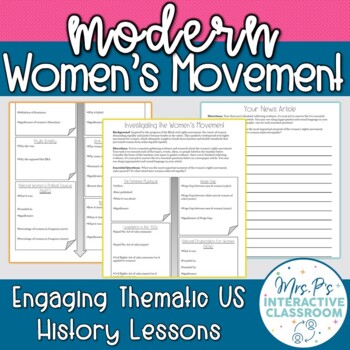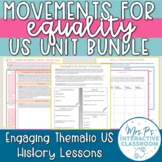Movements for Equality: Modern Women's Movement 1960-Present - Print & Digital
- Zip
- Google Apps™

Also included in
- Have you been looking for a meaningful way to teach your students about the diverse and rich movements for equality in US History? Do you want your students to go deeper into the content, learning about each movement and also comparing them? Do you want your students use a variety of primary sourcesPrice $57.00Original Price $64.50Save $7.50
- Ready to revolutionize the way you teach US History!? Wanting to go deeper than rote memorization? Desiring to spend more time developing an understanding of US History for your students rather than cramming in every detail?Ever since I first learned about teaching history by theme rather than straiPrice $125.00Original Price $147.00Save $22.00
Description
In this engaging research activity, your students will become investigative journalists intent on uncovering the modern women's rights movement (1960-present). They'll research key events, people, topics, ideas, and movements to better understand how modern women's rights have developed over time. Then, suing their newfound knowledge, they'll write their own news article in response to two essential questions.
Topics students will research: the feminine mystique, gender wage gap, Equal Pay Act, Civil Rights Act (1964), NOW, women's liberation, feminism, ERA, birth control, abortion (Roe vs. Wade), NWPC, and the #metoo Movement
For the news article, students will decide which moment of the modern women's rights movement was most important, while also exploring the extent to which modern women have achieved full equality.
The best part is that you can use this entire lesson for distance or digital learning! All student response resources come in a printable PDF version AND a Google Slides version. Students just make a copy and they can use the included resources!
Though this lesson is designed for an 80-90 minute block period, it can easily be broken into two 50-minute class periods.
Materials Needed:
- Computers for research
- Textbook (optional)
What's Included:
- 1 Written Warm Up (PDF, Google Slides)
- 2 Essential Questions
- Student Graphic Organizer for Research (PDF, Google Slides)
- Teacher Answer Key for Research Activity (PDF)
- Directions and Space for Student News Article (PDF, Google Slides)
- Rubric for Student News Article (PDF, Google Slides)
- Suggested Lesson Plan (PDF)
*Please note that none of the resources in this lesson are editable. Google Slides versions are linked in the lesson plans.
To reduce tech issues, please be sure to have the most recent free version of Adobe Reader downloaded. More help linked here.
You might also enjoy:
- Movements for Equality: American Women's Rights 1900-1950
- Women's Suffrage Lesson & Document Analysis
- Immigration Informative Essay
- Intro to Immigration Lesson & "Immigrants: We Get the Job Done" Viewing Guide
- US Economy: Great Depression & Stock Market Crash Lessons!
Want to learn more about teaching US History thematically? Check out my free US History Thematic curriculum map.
For freebies, teaching tips, and more, check out my blog and sign up for my weekly newsletter!
Follow my TpT store (follow star) so you don't miss a beat on updates and new resources!




